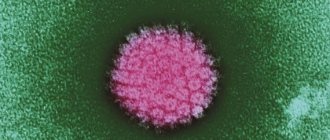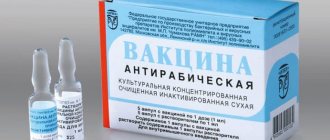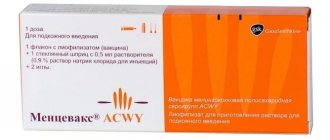Rebinolin (anti-rabies immunoglobulin from human serum)
Instructions for use:
REBINOLIN
Registration number:
LSR-008016/10 dated 08/12/2010.
Trade name of the drug:
Rebinolin.
Group name:
anti-rabies immunoglobulin.
Dosage form.
Solution for intramuscular and subcutaneous administration.
Compound.
1 ml of solution contains:
active substance:
anti-rabies immunoglobulin (human) - 150 IU.
excipients:
glycine, water for injection.
Description.
Transparent, slightly opalescent, colorless or pale yellow solution. May contain small suspended sediment which will break up when shaken.
Pharmacotherapeutic group.
Medical immunobiological preparation, globulin.
ATX Code:
J06BB05.
Pharmacological properties.
Pharmacodynamics.
Rebinolin is a buffered isotonic solution of specific human rabies immunoglobulin, obtained from the plasma of donors immunized with an inactivated vaccine for the prevention of rabies (prepared on the basis of a strain grown on a culture of human diploid cells), and containing a large amount of specific antibodies against the rabies virus. Administration immediately after infection forms passive immunity to the rabies virus, increases the duration of the incubation period and thereby contributes to effective vaccination during complex rabies immunoprophylaxis.
Pharmacokinetics.
The maximum concentration of antibodies is achieved 2-3 days after intramuscular injection of rabies immunoglobulin. The half-life (TVS) of antibodies is 3 to 4 weeks. Immunoglobulin G and immunoglobulin G complexes are destroyed in the cells of the reticuloendothelial system.
Indications for use.
Therapeutic and prophylactic immunization against rabies for any damage to the skin (bites, any wounds and scratches) caused by wild or domestic animals, sick with rabies, with suspected rabies, under veterinary supervision and outside it, as well as in contact with mucous membranes or damaged skin saliva from infected animals.
Contraindications.
Does not exist (100% mortality rate for rabies disease outweighs any contraindications).
Carefully.
in patients with a documented allergy to any component of the drug.
Use during pregnancy and lactation.
The use of this drug during pregnancy has not been studied in controlled clinical studies, therefore during pregnancy and lactation the drug should be prescribed only in cases where the expected benefit of therapy for the mother outweighs the potential risk to the fetus or infant.
Long-term experience with the medical use of immunoglobulins does not allow us to expect any harmful effects on the course of pregnancy, as well as on the fetus and newborn. It should be borne in mind that immunoglobulins are excreted in breast milk, which may contribute to the transfer of protective antibodies to the baby (passive immunity).
Method of administration and dose.
Intramuscularly, adults and children - 20 IU/kg (0.133 ml/kg), once. The dose should not be exceeded under any circumstances, because administration of immunoglobulin can partially suppress the production of one's own antibodies. If administration is anatomically possible, the maximum allowable portion of the drug dose should be administered by infiltration around the wound, and the remainder intramuscularly (into the upper outer quadrant of the buttock). The central part of the gluteal region should be avoided because... There is a risk of damage to the sciatic nerve.
At the same time, the first dose of the vaccine for the prevention of rabies (prepared on a culture of human diploid cells) is administered to another part of the body, preferably as far as possible from the site of administration of rabies immunoglobulin (preferably in the deltoid muscle area).
If therapy has been delayed for any reason, the drug should be administered no later than the eighth day after the first dose of the vaccine, regardless of the time interval between exposure to the virus and the start of therapy.
The drug should not be administered using the same syringe or into the same anatomical site of the body as the rabies vaccine.
To ensure good infiltration of affected areas of the body in children (especially those with multiple wounds), the dose of the drug can be diluted 2-3 times in a 0.9% sodium chloride solution.
Rabies immunoglobulin should be administered exclusively in combination with a vaccine to prevent rabies. The only exception is for persons who have already been vaccinated with a vaccine to prevent rabies and who have been confirmed to have rabies antibodies. These individuals should only receive the vaccine.
Therapy should be discontinued if the animal remains healthy during the 10-day observation period or if rabies virus is not detected in the sacrificed animal after appropriate laboratory testing.
Side effect.
Local reactions: pain and discomfort at the injection site.
Systemic reactions: hyperthermia, allergic reactions (skin reactions, anaphylactic shock, angioedema), dizziness, vomiting, decreased blood pressure, tachycardia.
Overdose.
Cases of overdose have not been described.
Interaction with other drugs.
Increases the effect (mutually) of vaccines for the prevention of rabies and is used in combination with them. The combination with an inactivated vaccine for the prevention of rabies, prepared on a culture of human diploid cells, is especially recommended, since the latter is highly immunogenic and induces active antiviral immunity.
Administration of immunoglobulins may adversely affect the effectiveness of vaccines containing attenuated live measles, rubella, mumps, or varicella viruses. Therefore, an interval of 3 months must be maintained between the administration of Rebinolin and the attenuated live vaccine. Compatible with antitetanus serum and antibiotics.
Special instructions.
Repeated administration of the drug should not be carried out after the start of an immunization program with a vaccine to prevent rabies, because may reduce maximum immunity.
Do not administer the drug intravenously (risk of anaphylactic shock). Before insertion, make sure that the needle does not penetrate the blood vessel.
Allergic reactions to rabies immunoglobulins of human origin when administered intramuscularly are rare. If shock develops, carry out standard therapy. In case of hypersensitivity to blood products (history), antihistamines should be used (careful monitoring of the patient is necessary).
As soon as possible after the bite and regardless of the time elapsed after contact, surgical and antiseptic treatment of the wound should be carried out (including copious washing with soap and water and disinfection using quaternary ammonium salts). After administration of the drug, the patient should be under medical supervision for at least 20 minutes. After administration of immunoglobulin, a temporary increase in antibody levels may cause false-positive results in serological tests. To avoid possible interactions between several different drugs, you should tell your doctor about any other therapy you are taking.
In order to avoid the risk of transfer of infectious pathogens, careful control of the selection of donor blood is carried out by examining each donated volume of blood and the total volume of plasma, especially in relation to the HIV-1, HIV-2 viruses, hepatitis B virus, hepatitis C virus, in addition, treatment with a detergent solution is carried out , heat treatment and nanofiltration.
Release form.
Solution for intramuscular and subcutaneous administration 150 IU/ml. 2 or 10 ml of the drug in bottles of colorless hydrolytic glass (USP) type I, hermetically sealed with rubber stoppers and crimped aluminum caps with a plastic lid (flip-off). 1 bottle along with instructions for use is placed in a cardboard box. Storage conditions.
At temperatures from 2 to 8 °C. Do not freeze. Keep out of the reach of children.
Best before date.
2 years.
Conditions for dispensing from pharmacies.
On prescription.
, Israel.
Antirabies immunoglobulin from horse blood serum liquid (Immunoglobulin antirabies)
Immediately or as soon as possible after a bite or injury, local treatment of the wound is carried out: the wound surface is washed generously with water and soap (or detergent), and the edges of the wound are treated with 70% alcohol or a 5% alcohol solution of iodine.
Immediate suturing of the wound is contraindicated; if necessary, a simple connection of its edges is permissible. Suturing is indicated exclusively in the following cases: for extensive wounds - several guiding skin sutures after preliminary treatment of the wound; for cosmetic reasons (skin sutures on facial wounds); suturing of bleeding vessels in order to stop external bleeding.
After local treatment of the wound, therapeutic and prophylactic immunization is immediately started. AIH must be administered no later than three days after being bitten or injured by a rabid or suspected rabid animal. The most effective administration of the drug is on the first day after injury.
Before injection, check the integrity of the ampoules and the presence of markings on them. The drug is not suitable for use: in ampoules with damaged integrity, labeling, as well as when its physical properties (color, transparency, etc.) have changed, if the expiration date has expired, or if stored improperly.
The opening of the ampoules and the procedure for administering the drug are carried out in strict compliance with the rules of asepsis and antiseptics.
AIH should be administered exclusively in combination with rabies vaccine, the first administration of which is carried out no more than 30 minutes after administration of AIH in a dose of 1 ml. The treatment regimen for AIH and rabies vaccine is shown in Table 1.
Table 1. Scheme of therapeutic and prophylactic vaccinations with rabies vaccine (AV) and rabies immunoglobulin (RAI)
| Category damage | Nature of contact | Animal details | Treatment |
| 1 | There is no damage to the skin, no salivation of the skin or mucous membranes. | Sick with rabies. | Not appointed. |
| 2 | Salivation of intact skin, abrasions, scratches, single superficial bites of the torso, upper and lower extremities (except for bites of dangerous localization: head, face, neck, hand, fingers and toes), inflicted by domestic and farm animals | If within 10 days of observation of the animal it remains healthy, then treatment is stopped (i.e. after the 3rd injection). If the absence of rabies in an animal is laboratory proven, then treatment is stopped from the moment the absence of rabies is established. In all other cases, when it is impossible to monitor the animal for 10 days (killed, died, ran away, etc.), continue treatment according to the specified scheme. | Start treatment immediately: AB 1.0 ml on days 0, 3, 7, 14, 30, 90. |
| 3 | Any drooling of the mucous membranes, any bites of the head, face, neck, hand, fingers and toes, genitals; single or multiple deep lacerations caused by domestic and farm animals. Any salivation and damage caused by wild carnivores, bats and rodents. | If it is possible to monitor the animal and it remains healthy for 10 days, then treatment is stopped (i.e. after the 3rd injection). If the absence of rabies in an animal is laboratory proven, then treatment is stopped from the moment the absence of rabies is established. In all other cases, when it is impossible to monitor the animal, continue treatment according to the specified regimen. | Start immediately combined treatment with rabies immunoglobulin: AIH on day 0 and rabies vaccine: AB 1.0 ml on days 0, 3, 7, 14, 30 and 90. |
AIH is administered at a dose of 40 IU per 1 kg of body weight of an adult or child. The volume of administered AIH should not exceed 20 ml.
Example:
the victim's body weight is 60 kg; AIH activity (indicated on ampoules and packs of the drug), for example, 200 IU in 1 ml. In order to determine the dose of AIH required for administration, you need to multiply the weight of the victim (60 kg) by 40 IU and divide the resulting number by the activity of the drug (200 IU), that is:
60×40/200= 12 ml
Before administering AIH, to detect sensitivity to a foreign protein, an intradermal test with anti-rabies immunoglobulin diluted 1:100 (ampoules are marked in red), which is located in a box with undiluted drug (ampoules are marked in blue), is mandatory.
Immunoglobulin diluted 1:100 is injected in a volume of 0.1 ml intradermally into the flexor surface of the forearm.
The test is considered negative if after 20-30 minutes there is no swelling or redness at the injection site or less than 1 cm. The test is considered positive if swelling or redness reaches 1 cm or more.
If the reaction is negative, 0.7 ml of rabies immunoglobulin diluted 1:100 is injected subcutaneously into the shoulder area. If there is no reaction, after 30 minutes, the entire calculated dose of AIH, heated to 37±0.5 °C, is administered in 3 divided doses with an interval of 10-15 minutes, taking the drug for each portion from previously unopened ampoules.
The calculated dose of AIH should be infiltrated around the wounds and deep into the wound. If the anatomical location of the injury (fingertips, etc.) does not allow the entire dose to be administered around the wounds, then the remainder of the AIH is administered intramuscularly to a site other than the vaccine injection (buttock muscles, upper outer thigh, shoulder).
Administration of AIH and rabies vaccine should not be administered to the same shoulder.
The entire dose of AIH is administered within one hour.
The most effective administration of the drug is on the first day after injury, but no later than three days.
If the intradermal test is positive (swelling or redness of 1 cm or more) or in the event of an allergic reaction to the subcutaneous injection, AIH is administered with special precautions. First, it is recommended to inject immunoglobulin diluted 1:100 into the subcutaneous tissue of the shoulder in doses of 0.5 ml, 2.0 ml, 5.0 ml with an interval of 15-20 minutes, then inject 0.1 ml of undiluted immunoglobulin and after 30-60 minutes inject intramuscularly the entire prescribed dose of the drug, heated to 37±0.5 °C, divided into 3 doses with an interval of 10-15 minutes.
Before the first injection, parenteral administration of antihistamines (suprastin, diphenhydramine, etc.) is recommended. In order to prevent shock, simultaneously with the administration of AIH, subcutaneous administration of a 0.1% solution of adrenaline or a 5% solution of ephedrine in an age-specific dosage is recommended:
When administering AIH, solutions of adrenaline, ephedrine, diphenhydramine or suprastin should always be ready.
After the administration of AIH, the patient must be under medical supervision for at least 1 hour. The first vaccination with rabies vaccine is carried out on the day of administration of AIH after the administration of the last one. The vaccination performed is registered in the established registration forms, indicating the dose, date, manufacturer of the drug, batch number, reaction to administration.





